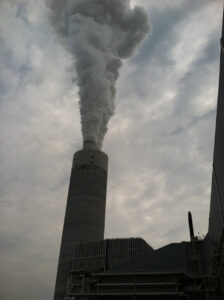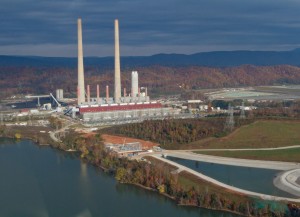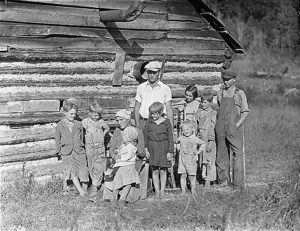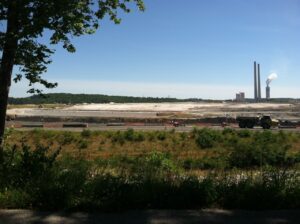Interview: Susie Hatmaker and ‘Flooded in Sludge, Fueling the Nation’

Susie Hatmaker is a doctoral candidate in American Studies at the University of Minnesota. In 2012, she received a Dissertation Fieldwork Grant to aid research on ‘Flooded in Sludge, Fueling the Nation: Generating Power, Waste, and Change in East Tennessee,’ supervised by Dr. Hoon Song. We reached out to Susie to learn more about her project examining how the 2008 Kingston ash spill, and other changes in Appalachia’s physical environment, are connected to an expose ideas of progress and technical development.
Let’s begin with a bit of background. Could you briefly summarize the project you undertook with your Dissertation Fieldwork Grant?
My project is a genealogy of the largest coal ash flood in US history that traces the intersecting forces that brought it into existence. And, it is a material analysis of the psychological and social processes that render this matter and this event largely invisible.
This grant supported an ethnography of the East Tennessee landscape where the flood took place. I inquired into how the landscape changed over time to accommodate this large body of coal ash waste. I traced various forces that connected in the accumulation of the ash, from ideas about the region’s people, to desires for national power and development. I combined an ethnography of the landscape with archival work at the National Archives and Smithsonian, where I looked into records of the Tennessee Valley Authority (TVA, a government agency that operates as a corporation, and whose Kingston power plant spilled the waste) and the Rural Electrification Administration, which together ushered in major changes in the relationship among landscape, infrastructure, the nation, and rural everyday life during the 20th century.
What happened in Kingston in 2008?
On December 22, 2008, over 1.1 billion gallons of coal ash waste flooded out of an unlined, earthen holding pond at a TVA power plant and spilled into the adjacent river. I was drawn to this event because it took place in my hometown. I saw Kingston on the news from my new home across the country, and couldn’t easily critique or place what I was witnessing. It shifted my consciousness. It was not related to the topics I intended to study in grad school, but once the flood happened (during the first year of my graduate program) I couldn’t stop thinking about the region, its history, and wanting to know more about how the coal ash came to exist in the holding pond.
How do you connect Science and Technology Studies (STS) and actor-network theory to 20th-century rural Appalachia?

This has been the largest challenge in defining this project – that I do not set aside a seemingly “cultural studies” set of concerns about the region’s history (the construction of Appalachia) in favor of my concern with the ash as a physical byproduct and material with its own story. I realized during research that certain ideas about “Appalachia” are essential to both the ways this landscape was developed in the name of modernization, and to the process of rendering this event insignificant, practically invisible. It’s not one of the “major” environmental disasters that we all know by a shorthand name. I hold that there is a key link between culturally salient ideas about “Appalachia” as a relic of the past, something “behind” modern time, and the ways the East Tennessee landscape in its contemporary manifestations is invisible. This is a place of scientific and technological complexity, home to the nation’s largest science and energy labs and a community that formed through the buildup of American modernity, most notably when Oak Ridge (which neighbors Kingston) was built as a Manhattan project site – the place where uranium was enriched for the first atomic bomb.
It is difficult to see a place as critical to American modernity, futurity, and development when it is continually positioned as a place of “backwardness,” and “the past within the present.” While Appalachia is a place where hikers and nature lovers seek rustic authenticity and American heritage, Oak Ridge is today a toxic Superfund cleanup site and the river that links it to Kingston is lined with the radioactive waste.
I use an STS/ANT approach to discuss how cultural narratives of Appalachia shaped the possibilities that planners and the national government could reasonably imagine for this terrain. That is to say, I look at how certain ideas combined with the presence of materials (such as coal, timber, and the many rivers and streams) to physically put materials, people, and terrain into motion.
I consider the invention of Appalachia (to borrow a phrasing from anthropologist Allen Batteau) not as simply a discursive construction, but as a socio-material process that emerged from a combination of human desires and physical realities. I view this as a trajectory in the network of forces that allows for the buildup of the coal ash. In each chapter of the manuscript, I describe physical conditions of everyday life, feelings, and ideas that put this matter into motion. The ash, in my writing, is both real and metaphorical – it is the main character in a story I am writing about the visible and invisible forces that give it life as a residue of the desire for power.
While working in the archive, you discovered a sizable collection of “propaganda films” created by the TVA. What was the content of these films? What sort of imagery did they deal in?

TVA was a major undertaking of the New Deal, and hinged on the creation of a new publicly funded government agency that basically took control over the entire Tennessee River and surrounding valley lands, built over 20 dams in a couple of decades, and later built coal-fired and nuclear power plants. This entailed massive displacements of communities, the creation of a system of huge new lakes, and federal regulation and policing of lakes, rivers, streams, and waterfront properties – all by this new agency, its managers, and its own police force. TVA also spearheaded the spread of electrification in its early days.
To convince the national population of the merits of this unprecedented level of federal control over life and land, there was a major corresponding propaganda campaign. What I found after watching dozens of these films is that they essentially created an origin myth to justify the necessity of intervention. The films repeatedly portray the local population pre-TVA as blighted, backward, and in need of assistance. They do not show things like Friday night dances, where people played live music, shared pies, and had fun. They didn’t show the kinds of active learning that took place on the farms and in schools, or the community as an organized entity that shared resources. The focus of the films was on lack of surplus capital (poverty), dirtiness, lack of “proper” clothing and shoes, etc. These films generally only portrayed the most desperate faces of rural, Depression-era poverty. In the collections of TVA’s in-house photographer, I was able to see a much broader picture of the pre-TVA landscape, including larger farmhouses, buildings, and local technologies that illustrate a more dynamic and economically varied region than the propaganda films allow.
The propaganda narrative focused solely on promoting the notion that this large-scale government intervention was necessary to bring the region into modernity and to spread light and power to the poor. Dam building is shown as a heroic act in the films, and workers appear like soldiers fighting a domestic war. Explosions of earth are heralded with triumphant music to signal a new era for this region. Once the dams are erected, scenes show peaceful panoramas of the newly created lakes and ordered recreation, indicating the ideal configuration of people, infrastructure, and environment.
You admit to encountering an overwhelming amount of information during your work in the archive and in the field. How do you decide “which stories to tell”?

I faced this most glaringly in the TVA archives. To give an example, TVA has several branches – power, agriculture, biology, geology, and many more. In the files of the power manager alone there are over 900 boxes. Similarly in fieldwork, I have notes on more interesting and compelling moments than I will be able to share. But while I may not get to directly cite all of these stories, reading them, and being immersed in them in the archive and in the field, all heightened my sensibilities about what to say and what is appropriate and accurate.
Recently, when writing a chapter based on my tour inside the Kingston Steam Plant, I found myself writing at length about a painting I saw there, which was noted by my tour guide as his “favorite part” of the plant. I could not stop writing about it, and this essentially became the focus of the chapter. I did not anticipate seeing this painting, nor did I plan to address it in my chapter outline, but in the process of writing, this is the story that worked. I found that through this singular, simple observation and encounter, that I could bring many ideas to life. As I work through the material and outline the writing, I find that it is mostly intuition and instinct that guides me toward figuring out what works, what to include, and what to exclude. It is very important to me that each story in each chapter serves the thesis of the project, and that the stories allow me to highlight the themes that run through the entire work. I have to consistently work to find the balance between rich, deep storytelling and showing a breadth of research. But a compelling story is more interesting to me, even if it is highly singular, than a compilation of copious amount of data and citation. This is especially true if I know that a particular story stands as a great example of a broader theme that recurs in this landscape and runs through the rest of the larger work.
What’s next for this project?
Right now I am working to finish writing this as my dissertation. I have an essay (“On Mattering”) out for review with a journal that I am excited about, and will share with the Wenner-Gren Foundation once it is published. After I graduate in May, I plan to focus on finding a publisher for the work and releasing it as a book.
Are you a current or past WGF grantee and interested in sharing your experience with us? Contact Daniel (dsalas@wennergren.org) for more information on our blog interviews.